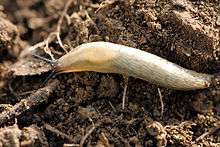Arion intermedius
| Arion intermedius | |
|---|---|
 | |
| Scientific classification | |
| Kingdom: | Animalia |
| Phylum: | Mollusca |
| Class: | Gastropoda |
| (unranked): | clade Heterobranchia clade Euthyneura |
| Superfamily: | Arionoidea |
| Family: | Arionidae |
| Genus: | Arion |
| Species: | A. intermedius |
| Binomial name | |
| Arion intermedius (Normand, 1852) | |
| Synonyms | |
|
Arion alpinus Pollonera, 1887[1] | |
Arion intermedius is a species of land slug in the family Arionidae, the roundback slugs. It is known commonly as the hedgehog slug,[2][3] hedgehog arion, or glade slug.[4] It is native to Western Europe, and it is known as an introduced species in many other regions, including North America, Australia, New Zealand, North Africa, South Africa, and the Pacific Islands.[4]
Description
This slug is 1.5 to 2 centimeters long. It is variable in color and patterning, being white, orange, or gray, with or without banding, and it has gray tentacles and a yellow or orange sole. It becomes compact and "nearly bell-shaped" when contracted.[3] The tubercles that texture the dorsal surface of its body taper to sharp, prickle-like points, inspiring the common name hedgehog slug.[3]
Biology
This species occurs in natural habitat such as grasslands and forests, and on cultivated or otherwise human-altered land, such as pastures, orchards, and hedges.[4] It feeds on plants and fungi.[5]
For a long time, this hermaphroditic slug was thought to reproduce only by self-fertilization; solitary captive specimens produced offspring and the species had never been observed mating. Genetic analysis provided evidence of crossing and the species is now believed to have a mixed breeding system, with an individual having the ability to fertilize itself or cross-fertilize, exchanging sperm with a mate.[6]
It is a univoltine species, laying one brood of eggs per year, generally in the fall. Most adults do not live through the winter.[7]
As a pest
This is not considered to be a severe pest or invasive species, but some reports of such problems have been made.[5] While most exotic slugs and snails are often found in altered environments, this species has a greater potential to invade natural habitat, such as forests. It may also displace native gastropod taxa. Its ability to self-fertilize allows a single individual to enter new habitat and then reproduce.[8] It is also known as a pest of clover-seeded pastures in New Zealand.[9]
References
- ↑ Manganelli G., et al. (2010). The status of Arion alpinus Pollonera 1887, and re-description of Arion obesoductus Reischütz 1973 (Gastropoda, Arionidae). Journal of Conchology 40, 269-76.
- ↑ Arion intermedius Normand. CSIRO & Australian Department of Agriculture, Fisheries and Forestry. 2004.
- 1 2 3 Arion (Kobeltia) intermedius Normand, 1852 (hedgehog slug). MolluscIreland. National Museums Northern Ireland, 2010.
- 1 2 3 Arion intermedius. NatureServe. 2013.
- 1 2 Slugs: A Guide to the Invasive and Native Fauna of California. Division of Agriculture and Natural Resources. University of California. 2009.
- ↑ Jordaens, K., et al. (2013). Mixed breeding system in the hermaphroditic land slug Arion intermedius (Stylommatophora, Arionidae). Hereditas publ. online ahead of print 24 October 2013.
- ↑ Bohan, D. A., et al. (2000). Parametric intensity and the spatial arrangement of the terrestrial mollusc herbivores Deroceras reticulatum and Arion intermedius. Journal of Animal Ecology 69(6), 1031-46.
- ↑ Cádiz, F. J. and C. S. Gallardo. (2007). Arion intermedius (Gastropoda: Stylommatophora); first record of this introduced slug in Chile, with notes on its anatomy and natural history. Revista Chilena de Historia Natural 80(1), 99-108.
- ↑ Barker, G. M. (1989). Slug problems in New Zealand pastoral agriculture. Monograph-British Crop Protection Council (41), 59-68.
- Spencer, H.G., Marshall, B.A. & Willan, R.C. (2009). Checklist of New Zealand living Mollusca. Pp 196-219 in Gordon, D.P. (ed.) New Zealand inventory of biodiversity. Volume one. Kingdom Animalia: Radiata, Lophotrochozoa, Deuterostomia. Canterbury University Press, Christchurch.
External links
- Arion intermedius at Animalbase taxonomy,short description, distribution, biology,status (threats), images
- Arion intermedius images at Encyclopedia of Life
